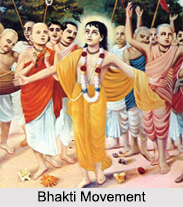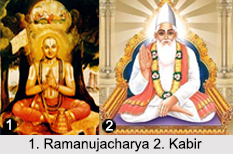 Bhakti movement was a Hindu religious movement of the medieval period that promoted the belief that Moksha was attainable by everyone. It was a silent revolution in the Indian society that was responsible for many rites and rituals associated with the worship of God by Hindus, Muslims and Sikhs. Kirtan at a Hindu Temple, Qawwali at a Dargah by Muslims and singing of Gurbani at a Gurdwara are all derived from the Bhakti Movement. Shankaracharya, the great thinker and a distinguished philosopher was the leader of this movement and Chaitanya Mahaprabhu, Namadeva, Tukaram and Jayadeva propounded this movement. The major achievement of Bhakti Movement was its abolition of idol worship.
Bhakti movement was a Hindu religious movement of the medieval period that promoted the belief that Moksha was attainable by everyone. It was a silent revolution in the Indian society that was responsible for many rites and rituals associated with the worship of God by Hindus, Muslims and Sikhs. Kirtan at a Hindu Temple, Qawwali at a Dargah by Muslims and singing of Gurbani at a Gurdwara are all derived from the Bhakti Movement. Shankaracharya, the great thinker and a distinguished philosopher was the leader of this movement and Chaitanya Mahaprabhu, Namadeva, Tukaram and Jayadeva propounded this movement. The major achievement of Bhakti Movement was its abolition of idol worship.
Citation of Bhakti Movement in Ancient Scriptures
The feeling of Bhakti or devotion can be traced back to the "Rig Veda". It is the very first hymn of Rig Veda, which gives expression to a feeling of intimacy with the highest God. In the "Katha Upanishad", it is said that the divine help, which is the reward to Bhakti, is necessary before one can be saved. The "Svetasvatara Upanishad" speaks of the highest devotion to God. Panini refers to the object of devotion in the "Ashtadhyayi". The earliest God connected with bhakti is Vishnu-Krishna. In the "Bhagavad Gita" there is emphasis on love and devotion to God. The attitude of love to the Supreme God continued to be recommended in the "Bhagavata Purana".
Features of Bhakti Movement
The main features of Bhakti Movement are as follows:
(i) A devotee could worship God by love and devotion. A loving relationship between a devotee and his personal God.
(ii) Bhakti emphasised devotion and individual worship of a God or Goddess rather than performance of elaborate sacrifices. There was no need to worship idols or to perform elaborate rituals for seeking his grace.
(iii) Discarding of any discrimination based on gender, caste or creed. There was no distinction of high or low as far as the devotion to God was concerned.
(iv) If a devotee worships the chosen deity with a pure heart, the deity will appear in the form in which he or she may desire.
 Development of Bhakti Movement
Development of Bhakti Movement
Bhakti Movement spawned into several different movements all across North India and South India. There were a number of factors, which contributed to the rise and growth of the Bhakti movement during the medieval period. They are as follows:
i. The first important factor was the destruction of Hindu temples by the invaders. They destroyed idols of Hindu Gods and Hindu Goddesses. The Hindus lost faith in the dependability of their religious rites and, therefore, chose the path of love and devotion.
ii. The second factor can be presumed as the persecution of Hindus by the Muslim rulers, who tried to convert them to Islam and imposed jaziya if they were not prepared to become followers of Islam.
iii. The third factor was the ill treatment of the lower classes in Hindu society by the persons of upper castes. The people of the lower castes had to suffer injustice and cruelties.
So the teachings of the Bhakti saints who preached equality of castes as far as the devotion to God was concerned appealed to the people of lower castes.
Indian Preachers of Bhakti Movement
Indian saints preached the concept of Bhakti Movement in the language of the common people. They laid stress on purity of heart and practice of virtues like truth, honesty, kindness, and charity. According to these saints, only virtuous man could realize God. These saints considered God as omnipresent and omnipotent. Even a householder could realize God by love and devotion. Some of the saints of Bhakti movement are mentioned below:
Ramanuja: The first great exponent of Bhakti was Ramanuja. He lived in the 11th century. He asked his followers to worship Vishnu. He did not believe in Sankara`s Advaita doctrine according to which the universal soul and the individual souls are one. According to Ramanuja, the individual souls exhale from him but are not essentially one with the Supreme Reality.
Ramananda: Ramananda flourished in North India in the 14th century. He entirely discarded the theory of caste system by birth. He preached the worship of Rama and Sita. Persons of all castes became his disciples. Among his chief disciples there was a barber, a blacksmith and a weaver. He preached in Hindi ,which was the language of the common man in northern India.
Kabir: The life of Kabir is totally unknown to the humankind. A true proponent of the Bhakti Movement, Kabir was a holy soul who further preached about the unity of Hindu and Muslim.
Guru Nanak : Nanaka was born in 1469 in the village to Talwandi. His parents belonged to Khatri caste. His father Kalu was the Patwari of the village. Nanaka was educated in the village school.
Vallabhacharya: Vallabhacharya was a Tailang Brahmin. He preached the worship of Vishnu in the form of Krishna. He was born in 1479 in the Telugu country. He visited Mathura, Vrindavan and many other sacred places and finally settled at Varanasi.
Chaitanya: Chaitanya was the greatest saint who preached the worship of Krishna and Radha. Chaitanya was born at Nabadwipa in 1486. His father Jagannatha Misra was a religious and scholarly man and his mother Sachi was also a pious and religious minded lady.



















